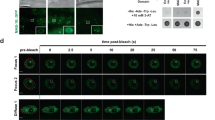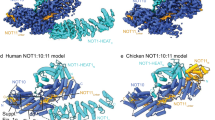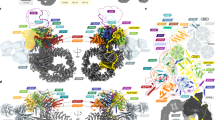Abstract
The DNA-binding domain of Skn-1, a developmental transcription factor that specifies mesoderm in C. elegans. is shown by X-ray crystallography to have a novel fold in which a compact, monomeric, four-helix unit organizes two DNA-contact elements. At the C-terminus, a helix extends from the domain to occupy the major groove of DNA in a manner similar to bZip proteins. Skn-1, however, lacks the leucine zipper found in all bZips. Additional contacts with the DNA are made by a short basic segment at the N-terminus of the domain, reminiscent of the ‘homeodomain arm’.
This is a preview of subscription content, access via your institution
Access options
Subscribe to this journal
Receive 12 print issues and online access
$189.00 per year
only $15.75 per issue
Buy this article
- Purchase on Springer Link
- Instant access to full article PDF
Prices may be subject to local taxes which are calculated during checkout
Similar content being viewed by others
References
Bowerman, B., Eaton, B.A. & Priess, J.R. Skn-1, a maternally expressed gene required to specify the fate of ventral blastomeres in the early C. elegans embryo. Cell 68, 1061–1075 (1992).
Bowerman, B., Draper, B.W., Mello, C.C. & Priess, J.R. The maternal gene skn-1 encodes a protein that is distributed unequally in early C. elegans embryos. Cell 74, 1–20 (1993).
Blackwell, T.K., Bowerman, B., Priess, J.R. & Weintraub, H. Formation of a monomeric DNA binding domain of Skn-1 bZIP and homeodomain elements. Science 266, 621–628 (1994).
Carroll, A.S. et al. SKN-1 domain folding and basic region monomer stabilization upon DNA binding. Genes Devel. 11, 2227–2238 (1997).
Pal, S. et al. Skn-1: Evidence for a bipartite recognition helix in DNA binding. Proc. Natl. Acad. Sci. USA 94, 5556–5561 (1997).
Patel, L., Abate, C. & Curran, T. Altered protein conformation on DNA binding by Fos and Jun. Nature 347, 572–575 (1990).
Weiss, M.A. et al. Folding transition in the DNA-binding domain of GCN4 on specific binding to DNA. Nature 347, 575–578 (1990).
O′Neil, K.T., Shuman, J.D., Ampe, C. & DeGrado, W.F. DNA-induced increase in the α-helical content of C/EBP and GCN4. Biochemistry 30, 9030–9034 (1991).
Santiago-Rivera, Z.I., Williams, J.S., Gorenstein, D.G. & Andrisani, O.M. Bacterial expression and characterization of the CREB bZip module: Circular dichroism and 2D 1H-NMR studies. Prot. Sci. 2, 1461–1471 (1993).
Granato, M., Schnabel, H. & Schnabel, R. Genes of an organ: molecular analysis of the pha-1 gene. Development 120, 3005–3017 (1994).
Mansukhani, A., Gunatne, P.H., Sherwood, P.W., Smeath, B.J. & Goldberg, M.L. Nucleotide sequence and structural analysis of the zeste locus of Drosophila melanogaster. Mol. Gen. Genet. 211, 121–128 (1988).
Smoller, D. et al. The Drosophila neurogenic locus mastermind encodes a nuclear protein unusually rich in amino acid homopolymers. Genes & Dev. 4, 1688–1700 (1990).
Kissinger, C.R., Liu, B., Martin-Blanco, E., Kornberg, T.B. & Pabo, C.O. Crystal structure of an engrailed homeodomain-DNA complex at 2.8 Å resolution: A framework for understanding homeodomain-DNA interactions. Cell 63, 579–590 (1990).
Wolberger, C., Vershon, A.K., Liu, B., Johnson, A.D. & Pabo, C.O. Crystal structure of a MATα2 homeodomain–operator complex suggests a general model for homeodomain-DNA interactions. Cell 67, 517–528 (1991).
Anderson, W.F., Ohlendorf, D.H., Takeda, Y. & Matthews, B.W. Structure of the cro represser from bacteriophage λ and its interaction with DNA. Nature 290, 754–758 (1981).
Jordan, S.R. & Pabo, C.O. Structure of the lambda complex at 2.5 Å resolution: Details of the represser-operator interactions. Science 242, 893–899 (1988).
Clarke, N.D., Beamer, L.J., Goldberg, H.R., Berkower, C. & Pabo, C.O. The DNA binding arm of λ represser: critical contacts from a flexible region. Science 254, 267–270 (1991).
Zhang, X-J. & Matthews, B.W. EDPDB: A multi-functional tool for protein structure analysis. J. Appl. Crystallogr. 28, 624–630 (1995).
Ellenberger, T.E., Brandl, C.J., Struhl, K. & Harrison, S.C. The GCN4 basic region leucine zipper binds DNA as a dimer of uninterrupted α helices: Crystal structure of the protein-DNA complex. Cell 71, 1223–1237 (1992).
Brennan, R.G. & Matthews, B.W. Structural basis of DNA–protein recognition. Trends Biochem. Sci. 14, 286–290 (1989).
Harrison, S.C. A structural taxonomy of DNA-binding domains. Nature 353, 715–719 (1991).
Talanian, R.V., McKnight, C.J. & Kirn, P.S. Sequence-specific DNA binding by a short peptide dimer. Science 249, 769–771 (1990).
Cuenoud, B. & Schepartz, A. Design of a metallo-bZIP protein that discriminates between CRE and AP1 target sites: Selection against AP1. Proc. Natl. Acad. Sci. USA 90, 1154–1159 (1993).
Park, C., Campbell, J.L. & Goddard, W.A. III Design and synthesis of a new peptide recognizing a specific 16-base-pair site of DNA. J. Am. Chem. Soc. 117, 6287–6291 (1995).
Holm, L. & Sander, C. Protein structure comparison by alignment of distance matrices. J. Mol. Biol. 233, 123–138 (1993).
Breiter, D.R. et al. Molecular structure of an apolipoprotein determined at 2.5A resolution. Biochemistry 30, 603–608 (1991).
Junius, F., O′Donoghue, S., Nilges, M., Weiss, A. & King, G. High resolution NMR solution structure of the leucine zipper domain of the c-Jun homodimer. J. Biol. Chem. 271, 13663–13667 (1996).
Andrews, N.C., Erdjument-Bromage, H., Davidson, M.B., Tempst, P. & Orkin, S.H. Erythroid transcription factor NF-E2 is a haematopoietic-specific basic-leucine zipper protein. Nature 362, 722–728 (1993).
Chan, J.Y., Han, X-L. & Kan, Y.W. Cloning of Nrf1, an NF-E2-related transcription factor, by genetic selection in yeast. Proc. Natl. Acad. Sci. USA 90, 11371–11375 (1993).
Caterina, J.J., Donze, D., Sun, C-W., Ciavatta, D.J. & Townes, T.M. Cloning and functional characterization of LCR-F1: A bZIP transcription factor that activates erythroid-specific, human globin gene expression. Nucleic Acids Res. 22, 2382–2391 (1994).
Mohler, J., Mahaffey, J.W., Deutsch, E. & Vani, K. Control of Drosophila head segment identity by the bZIP homeotic gene cnc. Development 121, 237–247 (1995).
Shapiro, L. et al. Structural basis of cell-cell adhesion by cadherins. Nature 374, 327–337 (1995).
Matthews, B.W. Solvent content of protein crystals. J. Mol. Biol. 33, 491–497 (1968).
French, S. & Wilson, K. On the treatment of negative intensity observations. Acta Crystallogr. A34, 517–525 (1978).
Otwinowski, Z. Unbiased refinement of heavy atom parameters in the isomorphous replacement method. In Daresbury study weekend proceedings. 80–89 (SERC Daresbury, Daresbury, UK; 1991).
Collaborative Computational Project Number 4. The CCP4 suite: programs for protein crystallography. Acta Crystallogr. D 50, 760–763 (1994).
McRee, D.E. Practical protein crystallography. (Academic Press, New York; 1993).
Read, R.J. Improved Fourier coefficients for maps using phases from partial structures with errors. Acta Crystallogr. A42, 140–149 (1986).
Brünger, A.T. Free R value: a novel statistical quantity for assessing the accuracy of crystal structures. Nature 355, 472–475 (1992).
Tronrud, D.E., Ten Eyck, L.F. & Matthews, B.W. An efficient general-purpose least-squares refinement program for macromolecular structures. Acta Crystallogr. A43, 489–503 (1987).
Tronrud, D.E. Knowledge-based B-factor restraints for the refinement of proteins. J Appl. Crystallogr. 29, 100–104 (1996).
Laskowski, R.A., MacArthur, M.W., Moss, D.S. & Thornton, J.M. PROCHECK: A program to check the stereochemical quality of protein structures. J. Appl. Crystallogr. 26, 283–291 (1993).
Brunger, A. Cross-validation in crystallography. Meths Enz. 277B, 366–396 (1997).
Hinnebusch, A.G. Evidence for translational regulation of the activator of general amino acid control in yeast. Proc. Natl. Acad. Sci. USA 81, 6442–6446 (1984).
Fjose, A., McGinnis, W.J. & Gehring, W.J. Isolation of a homeo box-containing gene from the engrailed region of Drosophila and the spatial distribution of its transcripts. Nature 313, 284–289 (1985).
Scott, M. et al. The molecular organization of the Antennapedia locus of Drosophila. Cell 35, 763–776 (1983).
Bohmann, D. et al. Human proto-oncogene c-jun encodes a DNA binding protein with structural and functional properties of transcription factor AP-1. Science 238, 1386–1392 (1987).
Kraulis, P.J. MOLSCRIPT: A program to produce both detailed and schematic plots of protein structures. J. Appl. Crystallogr. 24, 946–950 (1991).
Bacon, D.J. & Anderson, W.F. A fast algorithm for rendering space-filling molecule pictures. Mol. Graphics 6, 219–220 (1988).
Merritt, E.A. & Murphy, M.E.P. RasterBd version 2.0 - A program for photorealistic molecular graphics. Acta Crystallogr. D 50, 869–873 (1994).
Author information
Authors and Affiliations
Corresponding author
Rights and permissions
About this article
Cite this article
Rupert, P., Daughdrill, G., Bowerman, B. et al. A new DNA-binding motif in the Skn-1 binding domain–DNA complex. Nat Struct Mol Biol 5, 484–491 (1998). https://doi.org/10.1038/nsb0698-484
Received:
Accepted:
Issue Date:
DOI: https://doi.org/10.1038/nsb0698-484
This article is cited by
-
PMK-1 p38 MAPK promotes cadmium stress resistance, the expression of SKN-1/Nrf and DAF-16 target genes, and protein biosynthesis in Caenorhabditis elegans
Molecular Genetics and Genomics (2017)
-
The membrane-topogenic vectorial behaviour of Nrf1 controls its post-translational modification and transactivation activity
Scientific Reports (2013)
-
Conserved globulin gene across eight grass genomes identify fundamental units of the loci encoding seed storage proteins
Functional & Integrative Genomics (2010)
-
Energetics of the protein-DNA-water interaction
BMC Structural Biology (2007)



